|
Passer melanurus
(Cape Sparrow)
Gewone mossie [Afrikaans]; Ingqabe,
Undlunkulu, Unondlwana [Xhosa]; uNdlunkulu, uPhenyane [Zulu]; Serobele (generic
term for sparrows) [South Sotho]; Tswere (generic term for sparrows, petronias
and canaries [Tswana]; Kaapse mus [Dutch]; Moineau mélanure [French];
Kapsperling [German]; Pardal do Cabo [Portuguese]
Life > Eukaryotes > Opisthokonta > Metazoa (animals) > Bilateria > Deuterostomia > Chordata > Craniata > Vertebrata (vertebrates) > Gnathostomata (jawed vertebrates) > Teleostomi (teleost fish) > Osteichthyes (bony fish) > Class: Sarcopterygii (lobe-finned fish) > Stegocephalia (terrestrial vertebrates) > Tetrapoda (four-legged vertebrates) > Reptiliomorpha > Amniota > Reptilia (reptiles) > Romeriida > Diapsida > Archosauromorpha > Archosauria > Dinosauria (dinosaurs) > Saurischia > Theropoda (bipedal predatory dinosaurs) > Coelurosauria > Maniraptora > Aves (birds) > Order: Passeriformes > Family: Passeridae
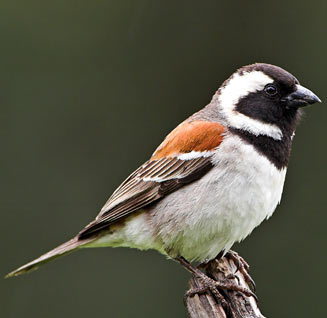 |
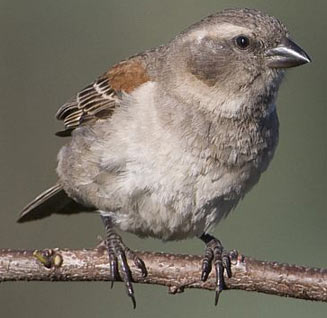 |
| Cape sparrow male, South Africa. [photo
Gerhard Theron ©] |
Cape sparrow female, West Coast National Park,
South Africa. [photo Trevor Hardaker ©] |
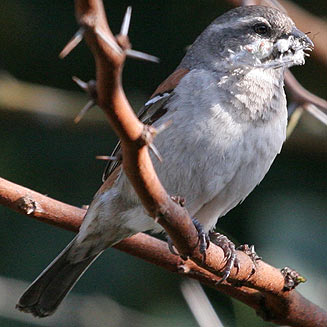 |
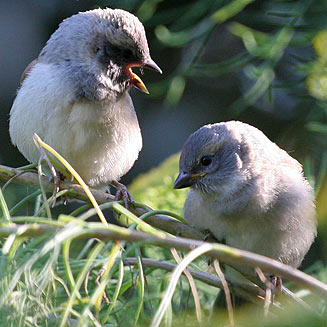 |
| Cape sparrow female, West Coast Fossil Park, Western Cape, South Africa. [photo H. Robertson,
Iziko ©] |
Cape sparrow juveniles, West Coast Fossil Park, Western Cape, South Africa. [photo H. Robertson, Iziko ©] |
Distribution and habitat
Near-endemic to southern Africa, occurring from
south-western Angola to Namibia (excluding the north-east), southern Botswana,
south-western Zimbabwe and across South Africa, where it is particularly common.
It generally prefers arid and semi-arid savanna, dry woodland along drainage
lines and many man-made habitats, such as farmland, alien tree plantations,
orchards, parks and gardens.
|
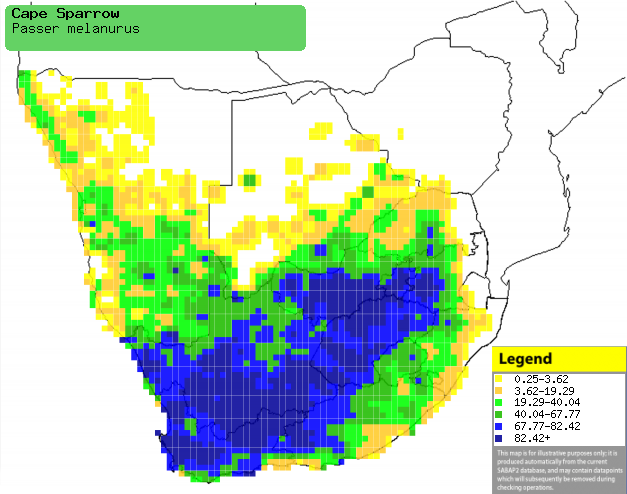 |
|
Distribution of Cape sparrow in southern Africa,
based on statistical smoothing of the records from first SA Bird Atlas
Project (©
Animal Demography unit, University of
Cape Town; smoothing by Birgit Erni and Francesca Little). Colours range
from dark blue (most common) through to yellow (least common).
See here for the latest distribution
from the SABAP2. |
Predators and parasites
It has been recorded as prey of the following animals:
Brood parasites
It has been recorded as host of the
Diderick
cuckoo.
Food
It eats a variety of insects and plant products, such as
seeds, fruit and nectar, doing most of its foraging on the ground or in low
vegetation. The following food items have been recorded
in its diet:
- Plants
- flower buds
- fruit and seeds of Lycium (honeythorn)
- seeds
- grasses, such as Enneapogon
- forbs and shrubs
- Polygonum
- Atriplex lindleyi (Blasiebrak)
- Chenopodium (misbredie)
- Boerhavia repens (Spiderling)
- alien trees, including Ulmus (elms)
- fruit
- nectar
- Aloe globuligemma (Beady aloe)
- Insects
Breeding
- Its breeding behaviour varies, as it is usually monogamous but sometimes
polygynous, nesting either singly or in colonies of up to roughly 100 pairs.
It often rears multiple broods in each breeding season.
- The nest is built by both sexes, consisting of an untidy hollow ball
with an entrance tunnel on the side, made of grass, weed stems and pliable,
woody plant fibres and lined with feathers or soft plant material. It is
typically placed in a bush, tree, hollow fence post, telegraph pole
crossbar, wire netting fence, under the eaves of a building or even in old
swallow or
weaver nest.
- Egg-laying season is mainly from August-March, peaking from
August-November in the Western Cape, but peaking later from
September-February in summer rainfall areas.
- It lays 2-6 eggs, which are incubated by both sexes for about 12-14
days.
- The chicks are brooded and fed by both adults on a diet of mainly
insects, leaving the nest after 11-20 days. They usually remain dependent on
their parents for food for about 1-2 weeks after fledging, but they
sometimes only become independent at approximately two months old.
Threats
Not threatened, in fact it has adapted well to the
modification of habitats by humans, and is now very common across much of its
distribution range.
References
-
Hockey PAR, Dean WRJ and Ryan PG 2005. Roberts
- Birds of southern Africa, VIIth ed. The Trustees of the John Voelcker
Bird Book Fund, Cape Town.
|
